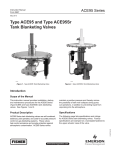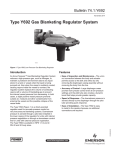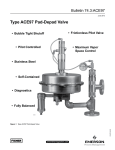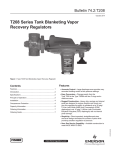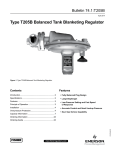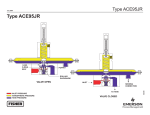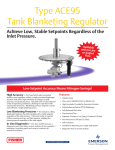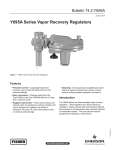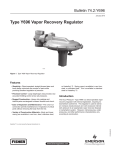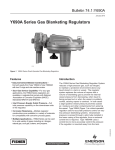Download Emerson ACE95Jr Data Sheet
Transcript
Bulletin 74.1:ACE95JR April 2012 Type ACE95jr Tank Blanketing Valve Features • Stainless Steel Construction Available • Fully Balanced Plug Design Reduces Inlet Pressure Sensitivity • Self-Contained • High Sensitivity • Bubble Tight Shutoff • Vacuum Settings Available W8157 Figure 1. Type ACE95jr Tank Blanketing Valve Introduction Type ACE95jr valves are self-contained, fully balanced, and used for accurate pressure control on tank blanketing systems. These valves help control emissions and provide protection against atmospheric contamination. Type ACE95jr valves maintain a positive tank pressure which reduces the possibility of tank wall collapse during pump out operations and prevents a stored product from vaporizing to atmosphere. D102722X012 Tank blanketing is the process of using a gas, usually an inert gas such as nitrogen, to maintain a slightly positive pressure in an enclosed storage tank. Tank blanketing prevents a stored product from vaporizing into the atmosphere, reduces product combustibility, and prevents oxidation or contamination of the product by reducing its exposure to air. Tank blanketing is utilized with various products, including: adhesives, pharmaceuticals, pesticides, fertilizers, fuels, inks, photographic chemicals, and food additives. www.fisherregulators.com Bulletin 74.1:ACE95JR Specifications Sizes and End Connection Styles 1/2 NPT 1 x 1/2 NPT 1 NPT NPS 1/2 / DN 15, CL150 RF NPS 1 / DN 25, CL150 RF NPS 1 x 1/2 / DN 25 x 15, CL150 RF NPS 1 / DN 25, Sanitary Flange Maximum Operating Inlet Pressure(1) 200 psig / 13.8 bar Maximum Emergency Outlet (Casing) Pressure(1) 20 psig / 1.4 bar Maximum Operating Control Pressure(1) 1.5 psig / 0.10 bar Control Pressure Ranges(1) See Table 1 Maximum Differential Pressures Up to 200 psig / 13.8 bar Main Valve Flow Characteristic Linear Pressure Registration External Capacities See Table 4 Temperature Capabilities(1) Nitrile (NBR): -20 to 180°F / -29 to 82°C Fluorocarbon (FKM): 0 to 212°F / -18 to 100°C Ethylenepropylene (EPDM - FDA): -20 to 212°F / -29 to 100°C Perfluoroelastomer (FFKM): -20 to 212°F / -29 to 100°C Flow Coefficients for Relief Valve Sizing (110% of rated Cv) Cv 0.2 use Cv 0.22 Cv 0.4 use Cv 0.44 IEC Sizing Coefficients XT: 0.655; FD: 0.86; FL: 0.89 Construction Materials Body: 316 Stainless Steel Trim: 304 Stainless Steel and 316 Stainless Steel Elastomers: Nitrile (NBR), Fluorocarbon (FKM), FDA-Ethylenepropylene (EPDM), or Perfluoroelastomer (FFKM) Diaphragm: Polytetrafluoroethylene (PTFE) Actuator: 316 Stainless Steel or Carbon Steel Approximate Weight (with all accessories) 30 pounds / 14 kg 1. The pressure/temperature limits in this Bulletin, and any applicable standard or code limitation should not be exceeded. Table 1. Control Pressure Ranges OUTLET (CONTROL PRESSURE RANGE) inches w.c. mbar SPRING PART NUMBER SPRING MATERIAL SPRING FREE LENGTH SPRING WIRE DIAMETER inches mm inches mm 69.8 22.4(1) 0.080 0.085 2.03 2.16(1) -5 to -0.5 -12 to -1 GC220701X22 Stainless Steel 2.75 0.88 -1 to 1 -2 to 2 GC220701X22 Stainless Steel 2.75 1.60 69.8 40.6(1) 0.080 0.065 2.03 1.65(1) 0.5 to 5 4 to 10 8 to 15 0.5 to 1.5 psig 1 to 12 10 to 25 20 to 37 34 to 103 GC220701X22 GC220702X22 GC220703X22 GC220708X22 Stainless Steel Stainless Steel Stainless Steel Stainless Steel 2.75 2.00 2.00 2.75 69.8 50.8 50.8 69.8 0.080 0.112 0.125 0.225 2.03 2.84 3.17 5.71 1. The second spring is located under the diaphragm assembly. Features and Benefits Options and Accessories Large PTFE Diaphragm—Resistant to corrosion and highly sensitive to changes in tank pressure. Inlet Pressure Gauge—Displays pressure of blanketing gas supply to the tank blanketing valve. Control Pressure Gauge—Low-pressure gauge to measure control pressure (tank pressure). Purge Meter (Rotameter)—Maintains a small amount of flow through the sensing or main line. Prevents corrosive tank vapors from damaging upstream equipment. Pressure Switch—Allows installation of an alarm system to indicate low or high-pressure on the tank. Fully Balanced—Eliminates setpoint changes caused by variations in inlet pressure. Large Actuator—Large actuator diaphragm increases sensitivity to tank pressure changes. Rolling Diaphragm—The rolling diaphragm balances the pilot valve and eliminates friction, resulting in extremely accurate control. 2 Bulletin 74.1:ACE95JR POPPET CAGE O-RING SEAT ROLLING DIAPHRAGM VALVE CLOSED SENSING CONECTION INLET VALVE OPEN TO TANK E0205 INLET PRESSURE ATMOSPHERIC PRESSURE TANK PRESSURE Figure 2. Operational Schematic Outlet Check Valve—Prevents corrosive gases and vapors from flowing back into the blanketing system through the delivery line. Single Array Manifold (SAM)—Provides sense line connection and main valve connection through a single tank nozzle. Inlet Filter—Screens out any foreign material upstream that may cause blockage in the gas flow. Principle of Operation The Type ACE95jr tank blanketing valve controls the vapor space pressure over a stored liquid. When liquid is pumped out of the tank or vapors in the tank condense, the pressure in the tank decreases. Tank pressure is sensed by the large actuator diaphragm. When tank pressure is less than the valve set pressure, spring force moves the actuator diaphragm downward. When the actuator moves downward, it pushes open the valve plug which allows flow in to the tank. See Figure 2. When pressure in the tank increases above setpoint, the large actuator diaphragm is pushed upward, allowing the valve plug to close. The valve plug is balanced (inlet pressure creates equal upward and downward force on these components); therefore, the outlet (control) pressure of the unit is not affected by fluctuating inlet pressure. Installation The Type ACE95jr tank blanketing valve was assembled and preset to the customer specified pressure and setpoint at the factory. The outlet (control) pressure range of the valve is stamped on the nameplate fastened to the upper actuator case. The gas blanketing setpoint is the only adjustable feature on this unit. 3 Bulletin 74.1:ACE95JR TYPE ACE95jr BLANKETING GAS SUPPLY LINE SENSING LINE LINE STRAINER SHUTOFF VALVE TYPE 252 INLET FILTER SHUTOFF VALVE TANK VENT SHUTOFF VALVE EMERGENCY TANK VENT BLANKETING GAS TO TANK TANK BLANKETING GAS/VAPOR SPACE LIQUID Figure 3. Type ACE95jr Tank Blanketing Valve Installation When installing Type ACE95jr, the sensing line and gasto-tank line must always be above the tank liquid level and should slope down towards the tank without any traps to avoid catching of liquid. Inlet supply line may be installed with a filter and the outlet piping should be full-sized and self draining to the tank and also valves and vents must be full line size and should be mounted above the tank. Sizing Methods Direct Displacement Use the direct displacement method with extreme caution. The direct displacement method determines the amount of blanketing gas required to replace liquid pumped out of the tank. Direct displacement does not account for fluctuating temperature or other factors that may affect pressure in the vapor space. This method is typically applied to tanks operating at constant temperatures and containing non-flammable, non-volatile products. 4 where, Qtotal Qpump Qtotal = Qpump = Required Flow Rate = Required Flow Rate to replace pumped out liquid from Table 2 API 2000 The American Petroleum Institute Standard 2000 (API 2000) sizing criteria accounts for liquid pump out as well as contraction of tank vapors due to cooling. When using API methods: where, Qtotal Qpump Qthermal Qtotal = Qpump + Qthermal = Required Flow Rate = Required Flow Rate to replace pumped out liquid from Table 2 = Required Flow Rate due to thermal cooling. See Thermal Equations 1 through 4 Bulletin 74.1:ACE95JR Thermal Equations Capacity Information For tanks up to 840,000 gallons / 3180 m3 capacity: Capacity tables are based on 0.97 specific gravity nitrogen. Nitrogen is the most common blanketing gas. Should you use a different gas, convert the tabular values as follows. For blanketing (pad) gases other than nitrogen, multiply the given nitrogen flow rate by the correction factors in Table 3. For gases of other specific gravities, multiply the given nitrogen flow rate by 0.985, and divide by the square root of the appropriate specific gravity. Equation 1: Qthermal [SCFH air] = Vtank x 0.0238 Equation 2: Qthermal [SCFH nitrogen] = Vtank x 0.0238 x 1.015 Equation 3: Qthermal [Nm3/h air] = Vtank x 0.169 Table 4. Capacities in 0.97 Specific Gravity Nitrogen Cv = 0.2, SCFH / Nm3/h INLET PRESSURE Equation 4: Qthermal [Nm3/h nitrogen] = Vtank x 0.169 x 1.015 where, For Equations 1 and 2: Vtank = tank volume, gallons For Equations 3 and 4: Vtank = tank volume, m3 Depending on the method, there can be a significant difference in the calculated required capacity. No matter which method is used, the tank must be equipped with supplemental venting to protect the tank, product, and personnel in cases of equipment failure, fire exposure, or other conditions that could cause the tank pressure or vacuum to exceed operating limits. Table 2. Flow Rate Conversion(1) MULTIPLY MAXIMUM PUMP RATE OUT: BY TO OBTAIN(1): U.S. GPM U.S. GPH m3/h 8.021 0.1337 1.01 SCFH SCFH Nm3/h Barrels/h Barrels/day 5.615 0.2340 SCFH SCFH 1. Gas flow of blanketing gas to replace liquid pumped out. psig bar kg/ cm2 kPa SCFH Nm3/h SCFH Nm3/h 1(1) 2(1) 5(1) 10 0.07 0.14 0.34 0.69 0.07 0.14 0.35 0.70 6.90 13.8 34.5 69.0 42 61 98 130 1.1 1.6 2.6 4.6 84 120 210 310 2.2 3.2 5.6 8.3 15 20 25 30 1.0 1.4 1.7 2.1 1.06 1.41 1.76 2.11 103 138 172 207 160 210 250 290 4.3 5.6 6.7 7.7 400 480 550 630 10.7 12.9 14.7 16.9 40 50 60 70 2.8 3.4 4.1 4.8 2.81 3.52 4.22 4.92 276 345 414 483 370 450 530 610 9.9 12.1 14.2 16.3 780 930 1070 1230 20.9 24.9 28.7 33.0 80 90 100 120 5.5 6.2 6.9 8.3 5.63 6.33 7.03 8.44 552 621 690 827 690 780 860 1020 18.5 20.9 23.0 27.3 1390 1560 1720 2040 37.3 41.8 46.1 54.7 140 160 180 200 9.6 11.0 12.4 13.8 9.85 11.3 12.7 14.1 965 1103 1241 1379 1180 1340 1500 1660 31.6 35.9 40.2 44.5 2360 2680 3000 3330 63.2 71.8 80.4 89.2 1. Assumes an outlet (control) pressure of 5-inches w.c. / 12 mbar or less. Ordering Information Table 3. Correction Factors (for converting nitrogen flow rates to other gas flow rates) BLANKET GAS SPECIFIC GRAVITY CORRECTION FACTOR Natural Gas 0.60 1.270 Air 1.00 0.985 Dry CO2 1.52 0.797 Correction Factor = Cv = 0.4, SCFH / Nm3/h Refer to the Specifications section on page 2. Carefully review each specification and construction feature, then complete the Ordering Guide. Also, please complete the Specifications Worksheet at the bottom of the Ordering Guide on page 7. 0.985 SG 5 Bulletin 74.1:ACE95JR 11.5 / 292 XP SWITCH PURGES CONTROL PRESSURE 11.8 / 300 8.5 / 216 INLET 8.2 / 208 B OUTLET INLET 1.6 / 40 8.6 / 218 A 2.5 / 64 SENSING CONNECTION 1/2 NPT Ø 12.5 / 318 INCHES / mm Figure 4. Type ACE95jr Dimensions Table 5. Type ACE95jr Dimensions BODY SIZE, NPS / DN DIMENSIONS STRUCTURE NPT CL150 RF Flange Sanitary A NPS DN 1/2 15 1 25 inches mm inches mm inches mm without Filter 3.7 94 9.7 246 ---- ---- with Filter 8.1 206 10.1 256 ---- ---- without Filter 7.5 190 9.8 249 9.4 238 with Filter 11.8 300 10.2 259 10.0 254 B 1/2 1 6 15 25 without Check valve 1.0 25 2.9 74 ---- ---- with Check valve 3.8 96 5.7 145 ---- ---- without Check valve 4.7 119 3.0 76 2.8 71 with Check valve 7.5 190 5.8 147 5.6 142 Bulletin 74.1:ACE95JR Ordering Guide Body Size and Connection Styles (Select One) 1/2 NPT 1 x 1/2 NPT 1 NPT NPS 1/2 / DN 15, CL150 RF NPS 1 / DN 25, CL150 RF NPS 1 x 1/2 / DN 25 x 15, CL150 RF NPS 1 / DN 25, Sanitary Flange Actuator/Diaphragm (Select One) Carbon Steel with PTFE Diaphragm Stainless Steel with PTFE Diaphragm Elastomers (Select One) Nitrile (NBR) Fluorocarbon (FKM) Ethylenepropylene (EPDM - FDA) Perfluoroelastomer (FFKM) Accessories (Optional) Inlet Pressure Gauge Control Pressure Gauge Purge Meter (Rotameter) Pressure Switch Outlet Check Valve Inlet Filter Single Array Manifold (Optional) Yes, please add a SAM unit to my order. Applicable only for 1/2 NPT body size and end connection. Parts Kit (Optional) Yes, please send one parts kit to match this order. Main Valve Coefficient (Select One) Cv - 0.2 Cv - 0.4 Control Pressure Range (Select One) -5 to -0.5 inches w.c. / -12 to -1 mbar -1 to 1 inch w.c. / -2 to 2 mbar 0.5 to 5 inches w.c. / 1 to 12 mbar 4 to 10 inches w.c. / 10 to 25 mbar 8 to 15 inches w.c. / 20 to 37 mbar 0.5 to 1.5 psig / 0.03 to 0.10 bar Specification Worksheet Application Specifications: Product in Tank Tank Size Pump In Rate Pump Out Rate Blanketing Gas (Type and Specific Gravity) Conservation Vent Setpoints: Pressure Vacuum Pressure Requirements (Please Designate Units): Maximum Inlet Pressure (P1max) Minimum Inlet Pressure (P1min) Control Pressure Setting (P2) Maximum Flow (Qmax) Regulators Quick Order Guide *** ** * Readily Available for Shipment Allow Additional Time for Shipment Special Order, Constructed from Non-Stocked Parts. Consult Your local Sales Office for Availability. Other Specifications: Is a vapor recovery regulator required? Yes No Other Requirements: Availability of the product being ordered is determined by the component with the longest shipping time for the requested construction. 7 Bulletin 74.1:ACE95JR Industrial Regulators Natural Gas Technologies TESCOM Emerson Process Management Regulator Technologies, Inc. Emerson Process Management Regulator Technologies, Inc. Emerson Process Management Tescom Corporation USA - Headquarters McKinney, Texas 75069-1872, USA Tel: +1 800 558 5853 Outside U.S. +1 972 548 3574 USA - Headquarters McKinney, Texas 75069-1872, USA Tel: +1 800 558 5853 Outside U.S. +1 972 548 3574 USA - Headquarters Elk River, Minnesota 55330-2445, USA Tels: +1 763 241 3238 +1 800 447 1250 Asia-Pacific Shanghai 201206, China Tel: +86 21 2892 9000 Asia-Pacific Singapore 128461, Singapore Tel: +65 6770 8337 Europe Selmsdorf 23923, Germany Tel: +49 38823 31 287 Europe Bologna 40013, Italy Tel: +39 051 419 0611 Europe Bologna 40013, Italy Tel: +39 051 419 0611 Chartres 28000, France Tel: +33 2 37 33 47 00 Asia-Pacific Shanghai 201206, China Tel: +86 21 2892 9499 Middle East and Africa Dubai, United Arab Emirates Tel: +971 4811 8100 For further information visit www.fisherregulators.com The Emerson logo is a trademark and service mark of Emerson Electric Co. All other marks are the property of their prospective owners. Fisher is a mark owned by Fisher Controls International LLC, a business of Emerson Process Management. The contents of this publication are presented for informational purposes only, and while every effort has been made to ensure their accuracy, they are not to be construed as warranties or guarantees, express or implied, regarding the products or services described herein or their use or applicability. We reserve the right to modify or improve the designs or specifications of such products at any time without notice. Emerson Process Management does not assume responsibility for the selection, use or maintenance of any product. Responsibility for proper selection, use and maintenance of any Emerson Process Management product remains solely with the purchaser. ©Emerson Process Management Regulator Technologies, Inc., 2001, 2012; All Rights Reserved









